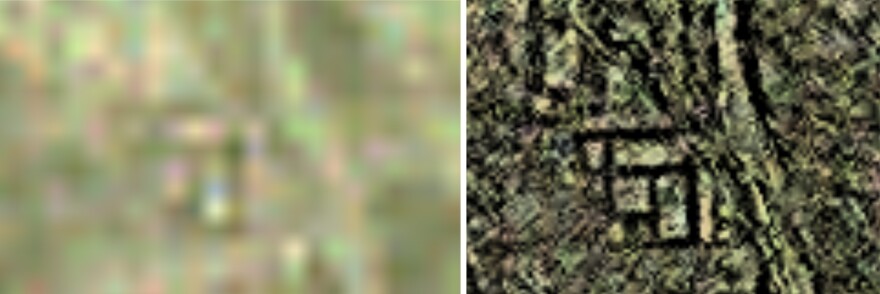Sarah Parcak is a space archaeologist. She uses satellite imagery to track looted ancient burial sites and find pyramids hidden under Egyptian cities. Now, she has bigger plans: to launch a worldwide campaign to make all of us space archaeologists.
She will be doing it through a digital platform called Global Xplorer, which will utilize crowdsourcing and satellite images to discover and protect unknown archaeological sites around the world. Parcak is the 2016 TED Prize winner — and she plans to launch the platform with the $1 million award that comes with the prize.
Parcak explains to NPR's Ari Shapiro how she plans to "game-ify" archaeological research and how she is enlisting everyone's help to pull it off.
"This is going to be a super high tech version of Google Earth," she says. "My team and I are going to process lots of satellite imagery and they'll be put on this platform."
Users will be given a small card from a deck that shows real, processed satellite imagery of a plot of land not more than 20 by 20 or 30 by 30 meters in size. There will be clues and keys by the side of the picture to help them identify whether they're seeing a known site, like a pyramid, or a new site.
But the satellite images can be blurry and it can be hard to distinguish patterns in them, even after the images are processed. To circumvent this problem, Parcak says users will actually be given two images: One that's unprocessed, one that's been enhanced. She wants users to compare the two pictures.
"When you look at images that are enhanced, the details pop much more," she says.

Parcak and her team will also help users identify the type of site or building in the images by allowing them to compare what they see with known examples of archaeological sites. For example, users can see pictures of what excavated Egyptian houses look like from different periods of time, so they can put tags on the pictures with the descriptions.
"As the crowd populates these images with their tags, after 10, 20 or 50 users tell us that something is there, we'll know to be able to check, to confirm, one way or another," Parcak says.
While everyone might not be an expert in archaeology or history, Parcak hopes that this method will help researchers identify more sites around the world, even in places where they never thought to look. Crowdsourcing, she says, will give them "lots of fresh pairs of eyes."
"The biggest problem we have when looking at satellite imagery is not the processing," she says. "The hardest part is actually eye fatigue. ... Imagine hours and hours looking at satellite imagery. We miss things."
The hardest part is actually eye fatigue. ... Imagine hours and hours looking at satellite imagery. We miss things.
Once enough users identify a site, Parcak and her team will look at the data, pick specific examples and share them with academic archaeologists who might go out and excavate the sites.
Here comes the best part: The crowd will be able to go along with them through applications like Periscope, Google Plus, Skype and Instagram.
There is one caveat to the plan, however: GPS information can be extremely sensitive and fall in the wrong hands. Parcak has spoken out against groups like ISIS raising money by looting archaeological sites, and this app may provide looters a map to find treasure. Parcak says these maps won't reveal GPS locations and will mask the data.
"We're treating an archaeological site as a human patient," she says. "We're protecting the actual data. ... We think by masking the location of the site we'll be pretty safe."
Parcak hopes to launch the application later this summer or by early fall.
"The idea is people can use this on their smartphones during their coffee break," she says. "We'll have a desktop version so people can use it in classrooms."
Her ultimate goal is to launch it globally, with the app hosting different languages.
"We're answering the big questions about who we are and where we've come from," she says. "And the fact that we can get the world to be a part of that is pretty exciting."
Copyright 2021 NPR. To see more, visit https://www.npr.org.


